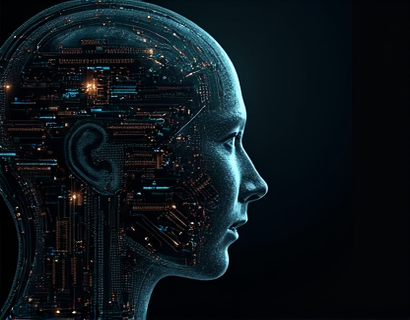Unlocking Enhanced Digital Experiences: Leveraging Crypto and AI for Ucosystem App Engagement
The digital landscape is rapidly evolving, driven by groundbreaking technologies such as cryptocurrency and artificial intelligence. These innovations are not just reshaping industries but are also transforming how users engage with apps and digital services. This article explores the synergy between crypto and AI, focusing on how these technologies can unlock next-generation digital experiences, enhance user interactions, and drive growth in the tech sector. For tech enthusiasts and professionals interested in the intersection of cryptocurrency, AI, and digital innovation, this piece offers valuable insights and strategies to leverage these advancements effectively.
At the core of this transformation is the integration of blockchain technology with AI. Blockchain provides a decentralized, secure, and transparent framework, while AI brings intelligence, automation, and personalized experiences to the table. When combined, these technologies can create robust, engaging, and secure digital environments that cater to the evolving needs of users.
Enhancing Security and Trust
One of the primary benefits of leveraging cryptocurrency in digital experiences is the enhanced security and trust it provides. Blockchain's immutable ledger ensures that transactions and data exchanges are tamper-proof, reducing the risk of fraud and data breaches. This is particularly crucial in app engagement, where user data and transactions are frequent and sensitive.
AI complements this by adding layers of security through advanced threat detection and response systems. Machine learning algorithms can identify and mitigate potential security threats in real-time, ensuring a safer environment for users. This dual approach not only protects user data but also builds trust, a critical factor in fostering long-term app engagement.
Personalization and User Experience
AI-driven personalization is revolutionizing user experiences across various platforms. By analyzing vast amounts of user data, AI can predict preferences, behaviors, and needs, allowing apps to deliver highly customized content and services. This level of personalization enhances user satisfaction and retention, as users feel understood and valued.
Cryptocurrency adds another dimension to personalization by enabling seamless and secure micro-transactions. Users can earn and spend tokens within apps, creating a more interactive and rewarding experience. For instance, users might earn tokens for completing tasks or engaging with content, which can be redeemed for premium features or rewards. This token-based economy incentivizes user participation and deepens engagement.
Decentralized Applications (DApps)
Decentralized applications, or DApps, are a prime example of how crypto and AI can synergize to create innovative digital experiences. DApps run on blockchain networks, leveraging AI to enhance functionality and user interaction. These applications are not controlled by a single entity, ensuring greater transparency and user control.
AI can optimize DApps by improving user interfaces, enhancing content recommendation systems, and automating administrative tasks. For example, AI-powered chatbots can provide instant customer support, while machine learning algorithms can refine content curation based on user interactions. This combination results in more efficient, user-friendly, and engaging applications.
Gamification and Incentives
Gamification is another area where crypto and AI intersect to boost app engagement. By incorporating game-like elements such as points, badges, and leaderboards, apps can motivate users to participate more actively. Cryptocurrency enhances this by providing tangible rewards in the form of tokens or coins.
AI can further enrich gamification by dynamically adjusting the difficulty and rewards based on user performance and engagement levels. Machine learning models can analyze user behavior to create personalized challenges and incentives, keeping users engaged and motivated. This adaptive approach ensures that the gamification elements remain fresh and appealing over time.
Data Privacy and User Control
Data privacy is a growing concern for users, and the combination of crypto and AI offers solutions to address this issue. Blockchain's decentralized nature means that users have greater control over their data, as they can choose what information to share and with whom. AI can enhance this by providing tools for users to manage their data preferences and consent settings seamlessly.
For instance, AI-driven dashboards can help users monitor and control their data usage across different apps and services. Blockchain ensures that these preferences are enforced and respected, creating a more private and user-centric digital environment. This empowerment fosters trust and loyalty, key components of sustained app engagement.
Fraud Detection and Prevention
Fraud remains a significant challenge in the digital world, affecting both users and businesses. AI algorithms excel in detecting patterns and anomalies that indicate fraudulent activity. When integrated with blockchain, these systems can provide real-time monitoring and immediate response to potential threats.
Crypto transactions are inherently transparent and traceable, making it easier to identify suspicious activities. AI can analyze transaction data to flag and prevent fraud before it occurs, ensuring a secure and reliable user experience. This proactive approach not only protects users but also enhances the reputation and credibility of the app or platform.
Tokenized Economies and User Motivation
Tokenized economies, powered by cryptocurrency, can create new incentives for user engagement. By issuing unique tokens that represent value within an ecosystem, apps can encourage users to participate actively. These tokens can be used for various purposes, such as accessing premium content, voting on platform decisions, or trading within a token marketplace.
AI can optimize the distribution and utilization of these tokens by analyzing user behavior and preferences. For example, AI can identify high-engagement users and reward them with additional tokens, creating a positive feedback loop that encourages more participation. This token-based motivation system aligns user interests with the app's goals, fostering a more engaged and loyal user base.
Scalability and Interoperability
As the number of users and transactions grows, scalability and interoperability become critical. Blockchain technology, particularly through the use of layer 2 solutions and cross-chain protocols, can enhance the scalability of crypto-based systems. AI plays a role here by optimizing network performance and resource allocation.
AI-driven analytics can predict traffic patterns and adjust resources accordingly, ensuring smooth and fast operations even during peak times. Additionally, AI can facilitate interoperability between different blockchain networks, allowing seamless interaction and data exchange. This interconnectedness expands the potential for innovative applications and services, further enriching user experiences.
Future Trends and Opportunities
The integration of crypto and AI is still in its early stages, with numerous opportunities for growth and innovation. As these technologies mature, we can expect to see more sophisticated applications in areas such as virtual reality, augmented reality, and the Internet of Things (IoT).
For instance, AI-powered virtual assistants integrated with blockchain-based VR environments can create immersive and secure experiences. Similarly, IoT devices connected through blockchain can benefit from AI-driven analytics to optimize performance and efficiency. These advancements will continue to push the boundaries of what is possible in digital engagement.
For tech enthusiasts and professionals, staying informed about these trends and actively experimenting with crypto and AI solutions will be crucial. By embracing these technologies, individuals and organizations can stay ahead of the curve, capitalizing on the next wave of digital innovation.
In conclusion, the synergy between cryptocurrency and AI holds immense potential for enhancing digital experiences. By focusing on security, personalization, gamification, data privacy, fraud prevention, tokenized economies, and scalability, apps and platforms can create more engaging, secure, and user-centric environments. As these technologies continue to evolve, the possibilities for transformative digital experiences are limitless.











































